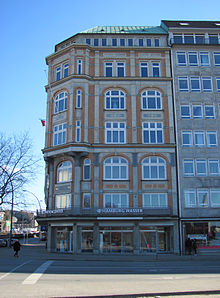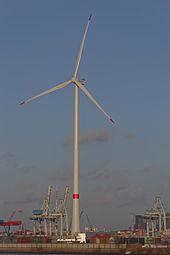Hamburg energy
| HAMBURG ENERGIE GmbH
|
|
|---|---|
| legal form | GmbH |
| founding | September 2009 in Hamburg |
| Seat | Hamburg |
| management |
|
| sales | 246.9 million euros (2018) |
| Branch | Energy supplier |
| Website | www.hamburgenergie.de |
The Hamburg Energie GmbH is a privately organized energy utilities (electricity and gas), which is 100% owned by the water company water Hamburg , for its part fully is the the Free and Hanseatic City of Hamburg is one.
history
Hamburg had sold the Hamburgische Electricitäts-Werke (HEW) in several steps from 1999 to 2002, initially under the direction of an SPD-led senate. When the last stake was sold to Vattenfall Europe AG , a subsidiary of the Swedish state company Vattenfall , von Beust was head of government.
Hamburg's former First Mayor Ole von Beust ( CDU ) described this sale as a mistake in 2007, stating that a state monopoly had "been replaced by a quasi-monopoly on the private side". In 2003, HeinGas Hamburger Gaswerke GmbH was also merged into E.ON Hanse AG, which is part of the E.ON Group .
Following a Senate resolution on May 12, 2009, the Supervisory Board of Hamburger Wasserwerke GmbH (HWW), chaired by the then Senator for the Environment, Anja Hajduk ( GAL ), approved the establishment of Hamburg Energie on May 15, 2009 and thus once again its own energy supplier. The entry in the commercial register followed . It was founded as a 100 percent subsidiary of HWW, which, together with Hamburger Stadtentwässerung (HSE), forms the equal order company Hamburg Wasser .
As a result of the Fukushima nuclear disaster in March 2011, Hamburg Energie, like the other pure green electricity providers , experienced a boom in demand, which led to 80,000 electricity customers and 10,000 gas customers being supplied at the end of May 2012. In April 2016, Hamburg Energie had 97,600 private electricity customers and over 18,000 gas customers.
Goals and motives for founding Hamburg Energie
As part of the master plan for climate protection, Hamburg has set itself the goal of reducing its energy-related carbon dioxide emissions by 40 percent by 2020 compared to 1990 levels. To do this, it has to reduce annual CO 2 emissions by 5.5 million tons compared to 2006 levels.
Against the background that the coal-fired power plant Moorburg and the associated district heating pipeline could not be prevented by the city of Hamburg and further conflicts with the Vattenfall Group, Hamburg Energie GmbH was founded in order to regain lost influence in energy policy.
The aim was to take over the energy networks (electricity, gas, district heating) in order to convert the urban energy supply to renewable energies, in particular to move away from nuclear energy and fossil fuels. The corresponding popular initiative of 2013, which aimed to remunicipalise the energy networks, was successful. The requirements were fully implemented in 2019 with the repurchase of the district heating network. Since then, Hamburg’s supply networks have been in the hands of the city again.
In October 2014 Hamburg Energie received the certificate “Pioneer of the energy transition” from TÜV Süd .
Green electricity
Since the market launch in autumn 2009, Hamburg Energie has only sold climate-friendly electricity , that is, electricity from renewable energy sources such as water and wind power (electricity label "Hamburg Energie").
Shore power
In order to reduce the environmental impact, the Hamburg Port Authority has been offering a shore power system at the cruise terminal in Altona since 2017 . Ships produce energy for the on-board systems even when they are in port. So that no fossil fuels have to be used, an overland power supply is possible, with Hamburg Energie serving as a green electricity supplier for the shore power supply in the Port of Hamburg.
Urban biogas
In addition to electricity, Hamburg Energie has also been offering natural gas products since August 2010 . These contain an admixture of biogas. The biogas is obtained from sewage gas in the Köhlbrandhöft sewage treatment plant . In addition to industrial, commercial and household customers, Hamburg Energie also supplies the municipal facilities in Hamburg, such as B. Schools, administration buildings and other properties.
Electromobility
Hamburg Energie is the green electricity supplier for the charging infrastructure in the Hanseatic city. In this role, the company takes on billing with all e-mobility providers (EMP) who provide charging cards for end customers in Hamburg and at the same time offers a tariff for e-mobility customers.
Delivery area
Hamburg Energie supplies grid areas in Hamburg as well as (parts of the Hamburg metropolitan region ) in the states of Schleswig-Holstein and Lower Saxony with electricity and natural gas and is also active in the generation of renewable energies in Hamburg and the Hamburg metropolitan region.
Power generation
Hamburg Energie aims to build a sustainable energy supply for Hamburg. To this end, the company invests in its own environmentally friendly energy generation plants within the Hanseatic city and in the metropolitan region. The first own system is the photovoltaic system on the former garbage dump in Hamburg-Georgswerder . The area is known today as the "energy mountain". Hamburg Energie is now the largest solar power producer in Hamburg with solar modules on the Millerntorstadion (home of FC St. Pauli) and the historic 50s Kaischuppen at the Hansahafen, and the company also generates green electricity in its own wind turbines . The municipal energy supplier is specifically looking for ways to produce electricity within Hamburg, which is a challenge due to the lack of open space. Systems from Hamburg Energie u. a. on the site of the ArcelorMittal steelworks and on the site of the Trimet aluminum smelter. Outside of Hamburg, Hamburg Energie cooperates, for example, with the Winsen (Luhe) municipal utility. As part of a cooperation, a joint wind farm was created that went into operation in 2018 and produces enough green electricity for over 20,000 households.
Hamburg Energie relies on the following types of production for energy generation:
- Photovoltaics
- Wind power
- Biomass
- Deep geothermal energy
- Digester gas recovery ( anaerobic decomposition )
Hamburg Energie Solar
At the end of 2009, Hamburg Energie founded the subsidiary Hamburg Energie Solar . The company's aim is to build 10 megawatts of additional solar power in Hamburg. For this purpose, the company provides a solar atlas for Hamburg, with which citizens can determine the solar potential of their roof areas. The company rents large roof areas for a longer period of time and builds them with solar systems itself.
As part of a citizen participation model , the necessary investments were partly raised through a citizen bond (4 million euros) so that private individuals can implement a decentralized “ citizen power plant ”. Hamburg Energie is currently (2012: 11.3 MW) the largest solar system operator in Hamburg.
Solar offensive
As a founding member of the Hamburg Solar Offensive, Hamburg Energie supports the Hanseatic city's climate goals by expanding photovoltaic systems on Hamburg's roofs. The initiative, founded in 2017, has set itself the goal of installing 5,000 additional solar power systems on Hamburg's roofs by 2020.
Customer center
In Hamburg city center , the common center of customers is Hamburg energy and the parent company Hamburg water at Ballindamm . 1
See also
Individual evidence
- ↑ Imprint. Hamburg Energie, accessed on January 18, 2019 .
- ↑ Annual Report 2018 (PDF; 2.58 MB) Hamburg Energie, May 2019, accessed on October 21, 2019 .
- ↑ Beust regrets the sale of HEW to Vattenfall , Spiegel Online, July 12, 2007
- ↑ We are Hamburg Energie. Hamburg Energie, accessed on January 18, 2019 .
- ↑ Successful second business year for HAMBURG ENERGIE ( Memento from November 3, 2012 in the Internet Archive )
- ↑ Hamburg Energie with the largest increase in customers since Fukushima ( Memento from April 1, 2018 in the Internet Archive )
- ^ A master plan for climate protection in Hamburg. business-on.de, October 21, 2010, accessed on January 18, 2019 .
- ↑ Clean electricity fills the city coffers , Die Tageszeitung, October 31, 2010
- ↑ EU approves buyback of district heating network , NDR, April 18, 2019
- ↑ District heating network belongs again to Hamburg , NDR, September 3, 2019
- ↑ TÜV confirms: Hamburg Energie, Baywa re and Lichtblick are pioneers of the energy transition. October 31, 2014, accessed July 23, 2016 .
- ↑ Green electricity for big pots. Hamburg Energie, accessed on February 13, 2018 .
- ↑ Hamburg continues to expand electromobility. hamburg.de, accessed on January 18, 2019 .
- ↑ Experiences, reviews and test reports on the electricity provider HAMBURG ENERGIE GmbH. Hamburg Energie, accessed on January 18, 2019 .
- ↑ Hamburg Energie is the first company in Germany to be awarded the new ok-power label. Hamburg Energie, March 30, 2011, accessed on January 18, 2019 .
- ↑ Topic solar energy on the Hamburg Energie website. Retrieved February 13, 2018 .
- ↑ Three wind turbines for ArcelorMittal Hamburg. ArcelorMittal, June 19, 2017, accessed January 18, 2019 .
- ^ The first wind farm in the port of Hamburg will commence operations at TRIMET. TRIMET, February 24, 2017, accessed on January 18, 2019 .
- ↑ wind farm. Stadtwerke Winsen (Luhe), December 15, 2017, accessed on January 18, 2019 .
- ↑ Hamburg Maritime Foundation and Hamburg Energie inaugurate the city's largest solar system. Hamburg Energie, April 27, 2012, accessed on January 18, 2019 .
- ↑ “Solar Offensive Hamburg” plans to build 5000 photovoltaic roof systems by 2020. pv magazine, September 20, 2017, accessed on January 18, 2019 .
Coordinates: 53 ° 31 '56.7 " N , 10 ° 2' 31.8" E


